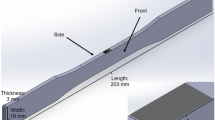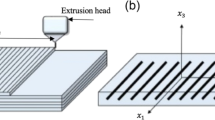Abstract
A nondestructive polyvinyl siloxane (PVS) impression protocol was developed for studying the surface features on joint prostheses with modular junctions after they have been removed from patients. Analysis of the failed joint prostheses reveals that modular junctions consisting of bore-cone tapers can be the site of in vivo fretting and crevice corrosion. While cone taper surfaces are readily analyzed by non-contact profilometric techniques, bore taper surfaces are inaccessible for direct observation. An indirect repeatable method to analyze these inaccessible surfaces was developed, incorporating a commonly used dental impression polymer to achieve a high-detail negative of the bore taper suitable for profilometric measurements. Compared to the actual bore surface, light-viscosity PVS adequately replicated surface features for statistically similar measurements of metrological mean roughness parameters (Sa, Sq), peak-to-valley height parameters (Sz), shape parameters (Ssk, Sku), and spatial parameters (Sm). Surface features as fine as 2.6 μm in size were reproduced, indicating that this technique is applicable to failure analysis studies involving abrasive wear, adhesive wear, and corrosion pits. This indirect and nondestructive method of surface damage analysis can be broadly applied in many industries requiring analysis of inaccessible surfaces, such as machined bores, inner surfaces of pipes, and large parts incompatible with laboratory metrology equipment.







Similar content being viewed by others
References
A. Srinivasan, E. Jung, B.R. Levine, Modularity of the femoral component in total hip arthroplasty. J. Am. Acad. Orthop. Surg. 20(4), 214–222 (2012)
J.B. Mason, Modular augments in revision total knee arthroplasty, in Revision Total Knee Arthroplasty, 1st edn., ed. by B.V. Bono, R.D. Scott (Springer Science & Business Media, New York, 2005), pp. 97–104
C.S. Helms, A.S. Greenwald, The rationale and performance of modularity in total knee arthroplasty. Orthopaedics 28(9), s1113-5 (2005)
J.D. Bobyn, M. Tanzer, J.J. Krygier, A.R. Dujovne, C.E. Brooks, Concerns with modularity in total hip arthroplasty. Clin. Orthop. Relat. Res. 298, 27–36 (1994)
M.K. Harman, M. Baleani, K. Juda, M. Viceconti, Repeatable procedure for evaluating taper damage on femoral stems with modular necks. J. Biomed. Mater. Res. B Appl. Biomater. 99(2), 431–439 (2011)
Standard Guide for Assessment of Surface Texture of Non-Porous Biomaterials in Two Dimensions, F2791-09, Annual Book of ASTM Standards, vol. 13.02, ASTM International, West Conshohocken
L. Blunt, X.Q. Jiang, Three dimensional measurement of the surface topography of ceramic and metallic orthopaedic joint prostheses. J. Mater. Sci. Mater. Med. 11(4), 235–246 (2000)
Standard Guide for Characterization of Wear from the Articulating Surfaces in Retrieved Metal-on-Metal and other Hard-on-Hard Hip Prostheses, F2979-14, Annual Book of ASTM Standards, vol. 13.02, ASTM International, West Conshohocken
T.E. Donovan, W.W. Chee, A review of contemporary impression materials and techniques. Dent. Clin. N. Am. 48(2), 445–470 (2004)
M.N. Mandikos, Polyvinyl siloxane impression materials: an update on clinical use. Aust. Dent. J. 43(6), 428–434 (1998)
Dental Elastomeric Impression Material, Section 5.11 Detail Reproduction, ISO 4823-2000, International Standards Organization
G. Derrien, G. Le Menn, Evaluation of detail reproduction for three die materials by using scanning electron microscopy and two-dimensional profilometry. J. Prosthet. Dent. 74(1), 1–7 (1995)
R. Delong, M.R. Pintado, C.-C. Ko, J.S. Hodges, W.H. Douglas, Factors influencing optical 3D scanning of vinyl polysiloxane impression materials. J. Prothodont. 10(2), 78–85 (2001)
A.B. Meireles, E.B. Las Casas, G.C. de Godoy, T.O. de Ornelas, T.P.M. Cornacchia, in Proceedings of the 21st Brazilian Congress of Mechanical Engineering, 24–28 Oct 2011, Natal, RN, Brazil, ABCM, 2011
Geometrical Product Specifications (GPS)—Surface Texture: Profile Method—Terms, Definitions and Surface Texture Parameters,ISO 4287:1997, International Standards Organization
Geometrical Product Specifications (GPS)—Surface Texture: Profile Method—Metrological Characteristics of Phase Correct Filters, ISO 11562:1996, International Standards Organization
J.M. Rodriguez, R.V. Curtis, D.W. Bartlett, Surface roughness of impression materials and dental stones scanned by non-contacting laser profilometry. Dent. Mater. 25(4), 500–505 (2009)
A. Panagiotidou, J. Meswania, J. Hua, S. Muirhead-Allwood, A. Hart, G. Blunn, Enhanced wear and corrosion in modular tapers in total hip replacement is associated with the contact area and surface topography. J. Orthop. Res. 31(12), 2032–2039 (2013)
P.E. Shrout, J.L. Fleiss, Intraclass correlations: uses in assessing rater reliability. Psychol. Bull. 86(2), 420–428 (1979)
Acknowledgments
This work was supported by the Clemson University Faculty Start-Up Fund. Explanted prostheses were provided by Jörg Lützner, MD.
Author information
Authors and Affiliations
Corresponding author
Rights and permissions
About this article
Cite this article
Panigrahi, P., Schwartzman, K.G. & Harman, M.K. Polyvinyl Siloxane Molds for Nondestructive Surface Feature Metrology of Failed Joint Prostheses. J Fail. Anal. and Preven. 15, 266–271 (2015). https://doi.org/10.1007/s11668-015-9925-8
Received:
Published:
Issue Date:
DOI: https://doi.org/10.1007/s11668-015-9925-8




